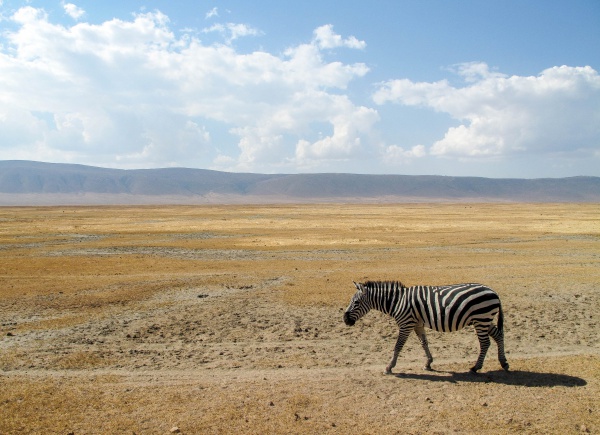There’s nowhere on earth as magical as Tanzania. From the floor of the Ngorongoro Crater to the peak of Mount Kilimanjaro, raw natural beauty blankets this entire East African country. In the north, the great plains of the Serengeti boast some of the best wildlife-watching experiences in the world. Here, the centuries-old quest for water and fresh grassland drives the epic wildebeest migration each year, and the Big Five roam wild, playing their parts in a cycle for survival. Nearby, the 3-million-year-old Ngorongoro Crater flourishes with a dense population of animals coexisting in one of the most exquisitely complex eco-systems on the planet. Home to grasslands, wetlands, mountain terrain, tropical forests, salt water and freshwater, the UNESCO World Heritage Site remains the single largest unbroken volcano caldera in existence; it’s often described as the place where God reached down and left his thumb print on Earth.
RELATED: 5 luxuriously chic eco-friendly hotels
For a destination so intensely defined by its wildlife, the people of Tanzania are wonderfully friendly and laid-back. Everywhere you go, you’re greeted with “Jambo!”—the Swahili word for hello, and the phrase “Hakuna Matata!” is thrown around just as often as the English equivalent, “No worries!” There are many amazing travel opportunities in Africa, but we’d argue, none as rewarding as the Tanzanian experience. So, follow along as we take you on a photo journey down into the crater and across the wild plains of the Serengeti.
All photos by Compass + Twine
An elephant in the Grumeti conservation area takes a regal stroll across the plains.
The one and only Mount Kilimanjaro. To access the famed safari routes of northern Tanzania, most travelers fly into Kilimanjaro National Airport. Before heading west towards Arusha, take a quick drive eastwards, towards the town of Moshi, to get the best views of Africa’s highest peak.
The central marketplace of Sanya Juu, a small town that lies on the foothills of Mount Kilimanjaro.
Up close and personal with a zebra in the Ngorongoro Crater. The abundance of wildlife within the walls of the crater also means an abundance of safari-goers. These animals will get a little closer than usual, since they’re more used to the sight of cars.
Looking pretty calm here, the African Buffalo, or Cape Buffalo, is regarded as one of the more aggressive and dangerous animals in Africa. Within the crater, they hang out in the grassy, savannah terrain and stick close to the water. | Photo by Compass + Twine
Bowing down? Antelope “play” on the crater floor.
At the end of the first day in the crater, we finally come upon some lions in the late afternoon. The mister approaches his lady, and we’re all about to get quite the show.
Guess you really do see the circle of life out here; although he looks to be enjoying the process a bit more.
…and she’s spent!
ALSO: Seren-get-it for less by signing up today for Orbitz Rewards!
A herd crosses the grasslands of the Ngorongoro Crater, as the fog rolls in.
Vultures rest on tree branches as they wait for their next scavenge.
Pumbaa! The word pumbaa means “slow witted” in Swahili, but it’s also an affectionate name for the wart hog. Check out this guy’s flowing mane.
A lone ostrich stretches his legs.
Not too concerned, this ostrich lets us get up close but still keeps his eye’s peeled for danger.
The Maasai tribes people live around the Great Rift Valley area of northern Tanzania and Southern Kenya. Generally nomadic, this specific family resides permanently on the outskirts of the Ngorongoro rim.
All smiles as our host shows us around his kraal, a circular village of huts occupied by his family and extended family.
Next stop—the Serengeti! Zebras greet us near the dirt airstrip in Grumeti, a 350,000+ acre acrea of conservation in the park.
Manyara Airstrip is the closest puddle-jumper airport used for accessing the crater. This area is also the eastern edge of the Great Rift Valley, and the views from above are spectacular.
A cheetah shelters himself from the midday heat under the shade of a tree.
Silhouettes of the Serengeti.
Watch out, she’s looking right at you. A lion sits waiting for the evening light to fade and her night hunting to begin.
Brilliant shades of tangerine electrify the sky over the Serengeti.
With their menacing expressions and mangy appearance, hyenas are some of the most mesmerizing animals to encounter.
A kill: As dusk turns to dark, a hyena takes down a baby wildebeest and is unfazed by the onlookers.
These deer are notorious for jumping spastically (and amusingly) in the air when they flee from danger.
You can almost see into the soul of this shy, old fellow.
One of the best luxury safari camps in the Serengeti, Singita Faru Faru lies within the protected Grumeti conservation area.
Elephants munch on foliage for lunch, while carefully staying in between us and the baby.
There’s nothing quite like seeing a herd of thousands of wildebeests fly past during the annual Great Migration north to Kenya, as they follow the rain and fresh grasslands.
A cheetah stalks his prey, blending in with the gold hues of the dry grass.
Another safari vehicle comes across a giraffe enjoying a snack in the trees.
A family of elephants takes an afternoon walk in the Serengeti.
Save
Save
